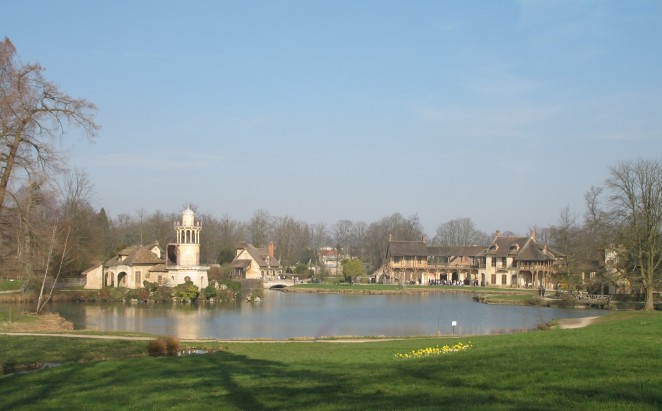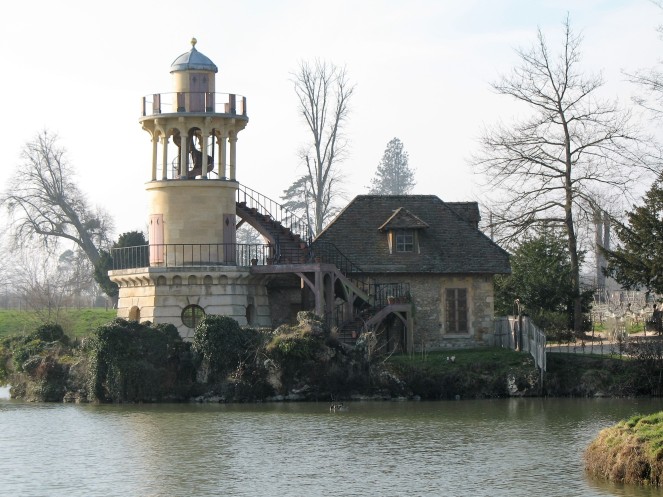Every once in a while, we all just want to get away. We’ve had enough of everyday life, the demands, the people, the noise. We just want to go play French peasant milk maid girl in our extravagantly designed, custom built, fully operational pretend peasant village. Right? No? Oh, that must be because you aren’t Marie Antoinette.
In 1783, Marie Antoinette, the last queen of France, had been living in the Palace of Versailles since her marriage to Louis XVI in 1770 at the age of 14. The girl had been through a lot. She was severely homesick upon her arrival in France, not ready for marriage (at 14 who would be?), or the constant demands put on her as first the Dauphine and then Queen of France (her husband was not king until 1774, therefore, until he became king and she queen, her title was the Dauphine of France). She was constantly surrounded by people, and married to a husband she couldn’t relate to. It took 7 years before her marriage was consummated, a source of stress due to the resulting lack of heir production, and during the course of her reign, she had become increasingly unpopular amongst the people of France. Rumors flew of her alleged promiscuity and decadent spending, all while whispers of revolution were growing louder with each passing day.
A girl’s gotta get some peace. So, what does a queen plagued by a negative public opinion rooted largely in her extravagant behavior and lack of regard for spending do? Why, she has an entire faux peasant village constructed in which to dress up like the simple folk as a means for amusement and relaxation. Oh, yes, and she has it built around her “Petit Trianon,” the small palace of her very own that her husband gave to her as a wedding present. Small wonder the starving people of France fancied a revolt.
The peasant village I speak of is actually called the Hameau de la Reine, or Queen’s Hamlet, and was designed by architect Richard Mique and painter Hubert Robert. Creating a pretend village was sort of a thing among aristocrats at the time. A way to escape and enjoy nature, simplicity, and rustic style while not giving up the luxury of aristocratic life. I mean, the idea sounds fun. Who wouldn’t like a pretend village in which to go play “dress up like a peasant in the picturesque French countryside” while not actually having to do any of the work of a peasant or endure the sufferings of an 18th century French citizen? Marie Antoinette’s Hamlet was essentially her very own theme park in which to play pretend. Paid for by the destitute people of France.

The queen would bring her friends to her Hamlet where they would forget all that nasty “revolution” talk, unwind, and unintentionally insult and infuriate the public. There’s something that those who are starving find irksome in a spoiled queen dressing up like the “simple folk” at the country’s expense. Especially when the farm in her make believe play land is producing lots of food. Lots of food, you say? Oh, yes. The village was complete with real animals and a queen -appointed farmer who lived in a house on the hamlet and ran the whole operation. The entire hamlet is comprised of twelve structures, all surrounding a small lake. Five were for the Queen’s use; the other seven were used to keep the farm operational.

For me, the whole concept of the queen’s hamlet begs the question: C’mon, Marie, did you really not know better?
It seems obvious that a move such as this would spark outrage amongst those who literally could not feed themselves – with cake or bread or much of anything else. But then I have to cut the queen some slack and wonder how much she really comprehended with regards to the contrast between her lifestyle and that of the people of France. To know something is one thing. To understand is quite another. After all, she was to be queen from the age of 14, and to say she had lived a privileged life is a monstrous understatement. Truly, the luxury of her Hamlet (and of her having a hamlet at all) pales in comparison to the luxury she was used to (gold this, gold that, over-the-top decadence everywhere). Anyone who has visited Versailles knows that it is so dripping with extravagance, you are practically dusted with gold when you leave.
Could she possibly have understood and anticipated the outrage and eye rolling her pretend village would cause given her upbringing? She clearly did not. In her mind, she was just trying to find a way to escape from her personal struggles, even if her personal struggles seem trivial, and dare I say, bratty, compared to the struggles of her people. Queen or not, she was still human, and means of escape knows many forms. Especially if you have unlimited funds.
As with all revolutions, The French Revolution was the result of numerous factors, all culminating in the explosion of revolution and change. Marie Antoinette’s Hamlet is just representative of one tiny jewel in the very heavy, very glittery, jewel-encrusted crown that the French people were ready to toss into the history books.
The hamlet was abandoned after the Revolution. It has now been restored and is open to the public.
https://dailypost.wordpress.com/category/daily-prompts/

Very interesting! Adding it to my bucket list right now! Xo
LikeLike
Loved this post!!! This is one of my favorite places I’ve ever been to. It’s preserved so well and it really does feel like an escape from the grandeur of the Palace.
LikeLiked by 1 person
Thank you, and I agree, it is so beautiful. One of my favorite places I’ve visited as well!
LikeLike